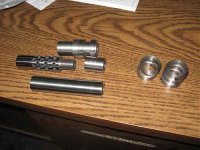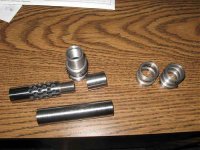2nd Day Testing
Okay, I'll follow up on last weekends test of the "Calfee-style" muzzle device that I posted about last week. I tested all day on Saturday.
1st. As I suspected, I could not get repeatable results with the same weight/load as the previous week. Using the same combination that had given my the teen agg (28.5 grains of H322), the best I could do was groups of .234, .298, .318, .324, and a ragged .413. Each of these groups showed noticeable vertical.
2nd. Next I tested the 2 shot 2 velocity thing, in an effort to repeat what had happened the week before. Loads were 27 and 30 grains. Last week, with 8.2 oz I could get the shots to converge from 1.3 inches apart to .3 inches. This week, I could not get the 8.2 ounces to place the shots any closer together than 1.1 inches together. By the way velocities were 30 grains = 3454 fps, 27 grains = 3128 fps (6ppc, 68 grain Bart's). KIDS, DON'T TRY THIS AT HOME.
3rd. Without the tuner, the 2 shot tests produced spacing identical to last week (1.3 inches). Last week, the 8.2 oz removed 1-inch of vertical. This week it only removed .200 inches.
4th. I then tried the 28.5 grains of H322 without the weight installed. Groups were better than with it: .238, .269, .312, .333, .345. Not good, but better.
5th. I then started testing to determine what weight would remove a large amount of vertical from the two widely-spaced shots. This week, 1.1 ounce did the best job ( I went clear up to 18 ounces). This weight removed about .750 worth of vertical.
6th. Shooting groups with the 1.1 ounce weight on did not produce anything better than was capable without the weight, even though it removed a lot of vertical from the 27/30 shots.
Conclusions based on the tests over 2 days:
Will the muzzle weight make 2 widely varying velocity shots move closer together? Yes.
Am I ever going to shoot rounds containing 3 grains of powder difference in a match? No, so I don't know why this is relevant.
Was I able to get repeatability with the muzzle weight? No, not on this date.
Did the muzzle weight do anything? Yes it did. With enough experimentation and trial and error, somebody might just figure this out.
Am I going to pursue this? Perhaps. But now the season is upon us. I spent Sunday preparing for our season opener. I need to think about this when winning some matches is not the focus of my shooting.
I am slightly disappointed (although not surprised) that I could not repeat the results of last week with the same weight, in the same place, with the same load. Nor am I surprised that I could make a DIFFERENT weight perform well. This is what I have been calling "tuner frustration" for years. I can make a tuner work well in every instance I have tried one--I just cannot make the same tuner, perform the same, every time I have used it. They all require adjusting, tweaking, and/or changing in some manner from one day to the next.
I know that there are those out there that believe that "once you get a tuner of the proper weight positioned correctly in the proper place" the gun will shoot like the proverbial house a fire, but I've never been able to produce such an animal.
I will keep searching.
God,I love this game!
Lisa Spendlove



